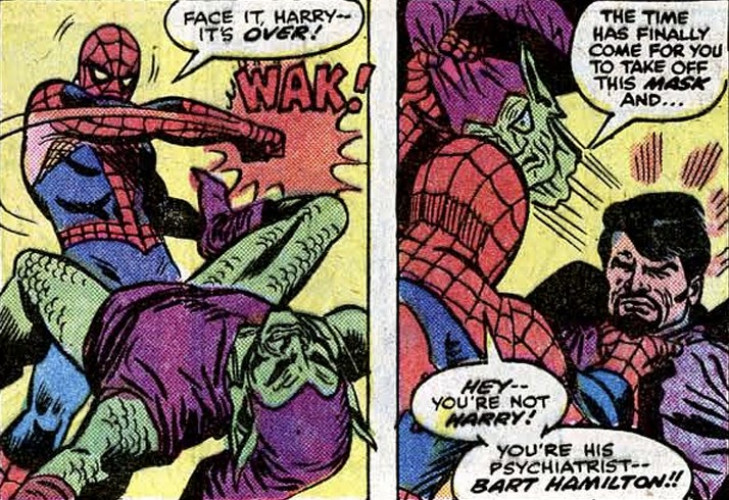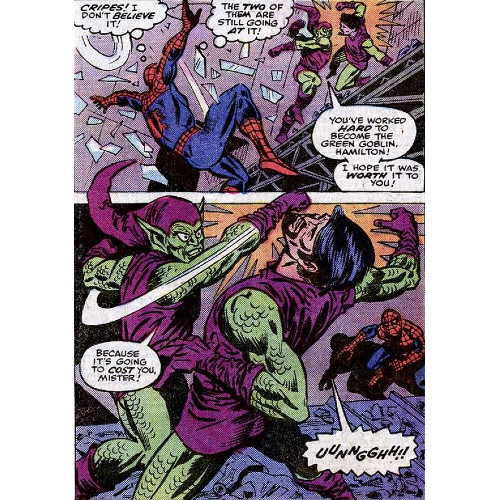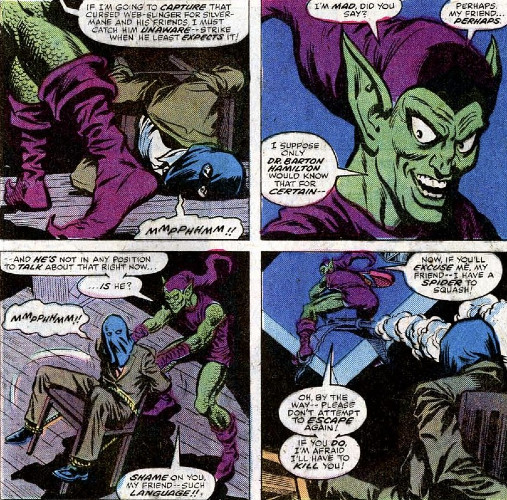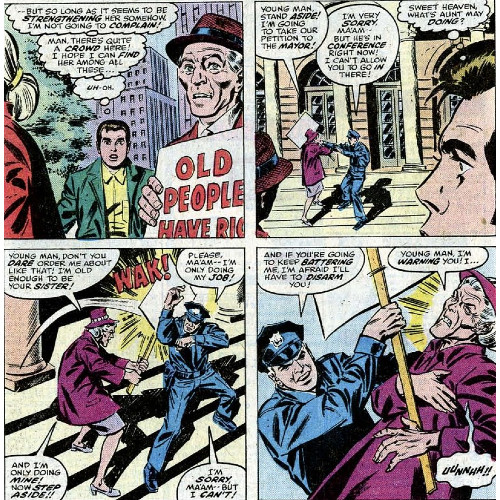Crawling Back: Amazing Spider-Man #176-180 Review (The Osborn Prelude, Part 11)
Len Wein delivers an arc that plays safe by combining several elements fans familiar with other Green Goblin stories will hopefully appreciate
—by Nathan on April 20, 2025—

Life has not been easy for Mister Harry Osborn.
Picture this: your dad's rich, but he's negligent in raising you, and he has to raise you on his own because your mom passed away. As you grow older, you think you find love in the arms of a red-headed young woman, only to learn she isn't as interested as you are. You become addicted to drugs and seek psychiatric help, just as your dad has done. Eventually, you learn dear old dad sought that help because of his periodic lapses into a costumed criminal persona who flew around on a glider and threw pumpkin bombs…only to die after killing your best friend/roommate's girlfriend, who was also your close friend. You blame that masked menace Spider-Man for his death, eventually learning he's your best friend/roommate! You grab Dad's identity, try to kill your former best friend/roommate, get sent away in a padded wagon, and go through therapy. You do get engaged to this other girl you love (not the red-head), but she leaves you at some point…maybe never to return?
What else?
Oh, yeah, that Spider-Man is now dating the red-head!
You can imagine Harry Osborn going over some of this with his psychiatrist Bart Hamilton, unpacking his many woes to try and get to the root of his many struggles. Where does one begin? With the deceased mom? The negligent father? The drugs? Believing your best friend pinned your dad to a wall after he killed your best friend's girlfriend/your close friend? Harry's been through a heckuva lot the last few years; no wonder he turns to a medical professional for help.
Then, one of his sessions goes sideways. He gets angry with Dr. Hamilton, and that anger erupts into violence. The two men wrestle, knocking over a lamp and darkening the room. From the struggle rises one victor, a shadowy man claiming the legacy of the Green Goblin.
But who? Does Harry don the mask again…or does a newcomer carry the cursed mantle of the grinning ghoul?
"He Who Laughs Last…"
Writer: Len Wein
Penciler: Ross Andru
Inkers: Jim Mooney, Tony DeZunga, Mike Esposito
Colorist: Glynis Wein
Letterers: Joe Rosen, John Costanza
Issues: Amazing Spider-Man #176-180
Issue Publication Dates: January 1978-May 1978

Coming in at five issues, this is the longest Green Goblin/Spider-Man narrative we've covered in this ongoing saga, and I'm gonna throw a 47-year-old SPOILER your way, because it's interesting that this is the longest story we've reviewed so far, and the villain of the piece isn't even Harry Osborn.
In a moment reminiscent of a Scooby-Doo cartoon, Spidey pops the Goblin's mask off in the final issue to discover Rart Ramilton…I'm sorry, Bart Hamilton's face peering out at him. The psychiatrist has gone psycho.
And then Harry appears in his own Goblin suit.

I gotta give Len Wein credit for creating an enthralling mystery, despite the fact I learned about this arc and its twisty ending about ten years prior to reading this story the first time. I tried to enter the mindset of a young reader in the late 70s, seeing the scruffy doctor's face instead of Harry's neatly manicured cornrows. The twist is telegraphed a little earlier when the penultimate issue ends with Harry removing his own "mask"–a sack thrown around his head by his doctor-turned-kidnapper. With knowing how ASM #179 ends, folks recalling the scuffle between Harry and Hamilton in ASM #175 would most likely have put two-and-two together. But until that moment? Wein plays the narrative surprisingly well.
Creating a third individual to wear the mask rather than rehashing the Peter/Harry conflict from ASM #136-137 is clever, preventing a cyclical manner of narrative from settling in (a complaint I had regarding a few of the later Norman Osborn stories). Wein teases enough that the reader could believe the Goblin could be Harry without tipping his hand towards the real twist, with the Goblin's dialogue toying with Spidey and the reader as to what's really going on. References to Harry and Hamilton could easily be taken to mean the Goblin is speaking figuratively about himself rather than another person, and though his motivations are different from Harry's (uniting the mob rather than killing Spider-Man), they align with Norman's earlier intentions, thus (perhaps) insinuating a familial link between the two…maaaybe? That could be stretching it a bit.

Regardless, I was impressed with Wein's ability to craft a fairly significant mystery, particularly in a manner that may have convinced some quasi-astute readers that nothing was amiss. As I noted, I attempted reading with a sense of ignorance, wondering if I would have been convinced by the mystery had I not already known the ending. I think I would have.
My biggest concern, knowing the ending before I even began reading, was how well Wein would sell me on Bart Hamilton as the Goblin. I couldn't remember much of this tale beyond its final twist, and I was curious if Wein could convince me that a man with no powers or experience could adapt to the toys and tools of the Goblin to effortlessly pull off the persona. I ultimately found Hamilton's backstory unconvincing, relegated to a few panels before his untimely demise. Is the idea of a psychiatrist succumbing to the same madness inflicting one of his patients interesting? Absolutely. Problematically, there's no space to explore that idea, thanks to the aforementioned "untimely demise."

I also didn't necessarily come to believe Hamilton could adapt as well to the Goblin gadgets as he does, and though Wein does nicely tease his lack of powers earlier (Spidey mocks his seeming lack of strength during their third confrontation), Hamilton comes across as far too professional far too quickly. More failings, more moments of vulnerability could have portrayed Hamilton as still somewhat of a novice, instead of a guy who awesomely hang-glides from his goblin glider.
And, yeah, it is awesome. Undeserved? Totally. But awesome? Absolutely. It's just the kind of trick Harry should be shown doing.

So the dramatic reveal, though based on a valid idea, rests on some unstable shoulders, but the narrative constructed around the moment is well-wrought. Additional conflict comes through the presence of gang members under Silvio Manfredi, the old mobster who'd later become the walking robot Shocker once affixed atop an RC car. Silvermane provides the story an interesting secondary antagonist, adding something a little grounded to the tale (and in more ways than one when the Goblin drops him from a great height); the gangster scenes bring to mind those early Norman Osborn adventures and provide Spidey some other guys to punch around when he isn't giving the Goblin a clobberin'. And Wein is a master of cliffhangers throughout the five issues–whether it's Flash Thompson thrown through a window, the Goblin threatening to reveal Spidey's identity to a roomful of gangsters, or Harry Osborn dramatically tearing off a hood, each chapter is ended in a way that makes you want to dive into the next issue.
Aside from the central mystery, Wein also squeezes ample tension from a subplot concerning Aunt May. During a protest outside city hall, Aunt May suffers a heart attack (the first of two in this tale!) after hitting a police officer, her most violent moment since pulling a gun on Spidey. She spends the rest of the story in the hospital, cared for by Anna Watson and MJ…and Peter, when he can be bothered to show up (seriously, it's like this guy leads a double life or something). Peter's concern for his aunt–not just from a medical perspective but also believing the Goblin will try to hurt her–is genuine, yet displayed in a lopsided manner to the circle of friends who find him negligent. Wein plays into that classic trope of Peter unable to be in two places at once, placing his Spidey responsibilities over his personal life, deriving frustration from his friends and guilt on his own behalf.

"Classic" can sum this tale up, not in that it's necessarily a definitive standalone banger itself, but in that Wein is heavily reliant on what has come before. Aunt May's health issues, Peter's torn attitude towards responsibility, a Goblin identity mystery, the Green Goblin's attempted takeover of the mob, a Green Goblin accidentally dying by their own hand…all those "classic" elements are in play here. Wein wisely subverts the mystery bit, playing with the audience's beliefs and crafting, again, a fairly compelling central enigma for our hero to unravel (even if Spidey's participation in "discovering" the new Goblin's identity is largely inadvertent). Otherwise, this tidy tale is fairly safe, constructed purposefully to appeal to the wide readership. That's not a knock against what Wein does–he's certainly not the only writer to have sent Aunt May to the hospital as a nod to the Lee/Ditko days–and maybe it makes the big twist more palatable. I think most readers can only accept so much change, so Wein provides a solid foundation on which to build his narrative…and as he removes pieces, like a Jenga tower, he's smart enough to prevent the whole structure from collapsing.